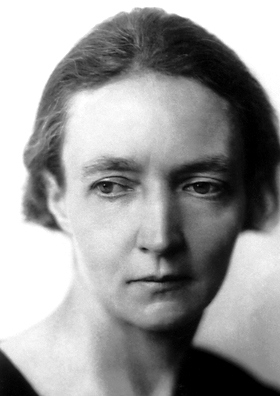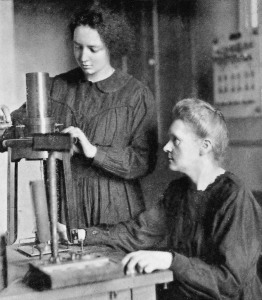Irène Joliot-Curie was a Nobel Prize winning chemist, and daughter of famed scientist Marie Curie.
When it comes to great women from history, almost everyone has heard of Marie Curie, the great scientist who won two Nobel Prizes. Less well known is her equally brilliant daughter, Irène.
Irène was born on 12th September 1897 in Paris where her famous parents Marie & Pierre lived. She went to school when she was 10, but only stayed for a year; her parents had noticed how clever she was, especially at maths and wanted to develop her gift. Marie and other scientists living in Paris at the time formed an educational group which they called ‘The Cooperative’. The scientists took it in turn to teach one anothers children in their homes, it was an amazing start for young Irene. As well as teaching them science at a higher level than at school, they also encouraged creativity, self-expression and play.
After two years learning with The Cooperative Irène went on to the College Sevigne, and then to the Faculty of Science at the famous Parisian college, The Sorbonne. Unfortunately just as her studies were getting underway the First World War broke out. At just 17 years old Irène was sent to the countryside where it would be safer, however she didn’t stay out of harms way for long. She soon joined her mother in establishing and running mobile x-ray units for wounded soldiers. Irene helped her mother to create 20 mobile x-ray vehicles and another 200 units at field hospitals during the first year of the war. They also began to train other women in how to use the technology.
When the war ended Irene was able to resume her studies, this time at The Radium Institute(which her parents had founded!) She became a Doctor of Science in 1925.
It was while she was studying here that she met her partner, Frédéric Joliot. He said of Irène that “With her cold appearance, her forgetting to say hello, she didn‘t always create sympathy around her at the laboratory. In observing her, I discovered in this young woman, that others saw as a little brutish, an extraordinary, poetic and sensitive being.”
In 1926 the pair married, and instead of becoming Mrs Joliot, they decided that they would both adopt each others names, becoming the Joliot-Curies. They began working together in the field of chemistry & radiography building on the work that Irène’s parents had done.
In 1934 they made several important discoveries to do with changing one element into another. It was this work that won them the Nobel Prize in Chemistry the following year. (This made the Curies the family with the highest number of Nobel Prizes!) Irène was made a professor at The Sorbonne and the couple became quite famous in the scientific world.
Irène opposed the fascist movement that had gained popularity in some parts of Europe, joining the Socialist Party in 1934 and supporting freedom fighters in the Spanish Civil War. In 1936 she was made Undersecretary of State for Scientific Research by the French government .
Just as her parents had, Irène & Frédéric used to make all of their work public. However, as the Second World War began they decided that some of their research could be very dangerous in the wrong hands. They locked all their research into nuclear fission in the vaults of the French Academy of Science, where it stayed until 1949.
After the war had ended Irène was made the Director of The Radium Institute and continued to inspire other scientists. She was also a great champion of women’s rights, especially in advocating for education for women. Later in her life she joined the National Committee ofthe Union of French Women, and also served on the World Peace Council.
Sadly, as had been the fate of her mother, Irène’s body had been badly affected by the radiation she was exposed to in her work. She developed leukemia and eventually died from it in 1956, aged 58.
In an obituary published in Nature James Chadwick wrote,
“She knew her mind and spoke it, sometimes perhaps with devastating frankness; but her remarks were informed with such regard for scientific truth and with such conspicuous sincerity that they commanded the greatest respect in all circumstances.”
Today many people have probably not heard the name Irène Joliot-Curie, although most will have heard of her mother. Her name is remembered in one unusual place however; there is a crater on Venus which is named after her (bizarrely it seems that there are quite a few craters on Venus named after Sheroes of History! Have a look here.) There is also an annual Irène Joliot-Curie prize given in France to exceptional women in science.
Find out more…
You can read Irène’s acceptance speech for her Nobel Prize here.
There are a couple of books about Irène. This one and this one are both available, but are both in French so only for those fluent in the language!
This short video gives a timeline of Irène’s life:
This post originally appeared on the Sheroes of History blog. Sheroes of History is an exciting project telling the fascinating stories of history’s forgotten heroines. The aim of the blog is to raise the profile of these incredible women and provide a broad range of inspiring role models for girls growing up today. If there is a Shero you would like to write about for the site you can get in touch and submit your idea. Follow Sheroes of History @SheroesHistory and like them on Facebook for loads more women’s history updates!



